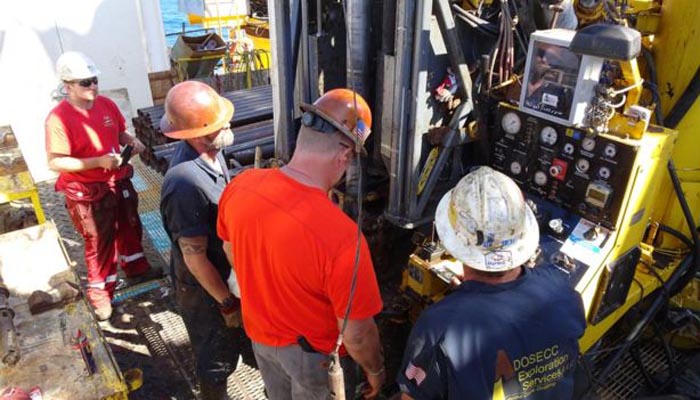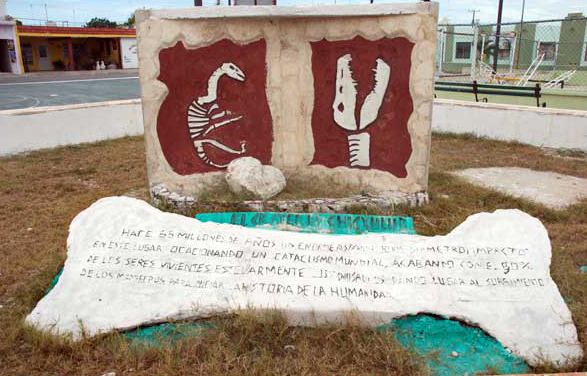Tag: Chicxulub crater
Chicxulub to get its very own ‘Jurassic Park’
Construction began today at a new attraction near the entrance to Chicxulub, in the municipality of Progreso.
Space dust beneath Chicxulub Crater confirms asteroid impact
The 2016 scientific drilling expedition off the coast of Yucatán has yielded space dust, evidence that the asteroid impact and dinosaur extinction are "indisputably...
Love cenotes? It may turn out that you have a comet...
The asteroid that killed off the dinosaurs and created the Chicxulub crater in Yucatán may have not been an asteroid after all.
Scientists at Harvard...
Chicxulub Puerto petitions to split from Progreso
Paperwork has been filed to make the port town where the famous crater gets its name its own independent municipality.
Curious scientists plan more drilling at Chicxulub crater site
Merida, Yucatan — Hungry for more clues to the earth's history and the demise of the dinosaurs, the leader of a previous expedition wants to...
Chicxulub meteor contains rare cancer-fighting metal, British researchers say
The meteor that left the Chicxulub Crater might have wiped out the dinosaurs, but could contain a cancer-curing cancer, reports a British news agency.
Chicxulub Crater museum months behind schedule
Too few people appreciate how the Chicxulub Crater impact changed the world, a prominent scientist says.
Chicxulub crater study reveals broken rocks can flow like liquid after...
A new study of an unusual ring of smashed rocks beneath the Yucatán Peninsula has brought fresh insight into the Chicxulub crater mystery.
Chicxulub drilling to return in 2019, on both land and sea
Excited by what they found off the coast of Yucatán, scientists are returning for seconds.
Chicxulub asteroid impact may also have triggered volcanos
The asteroid impact on the Yucatán Peninsula, not only wiped out the dinosaurs but also may have set off a chain of cataclysmic volcanic eruptions, claims a divisive new study.
Chicxulub Crater Museum expected to be completed by July
The Chicxulub Crater Museum, which is about 60 percent done, will be completed in July, a state agency announced.
Highly anticipated new game is set at Chicxulub crater
It looks like GTFO, the creepy action/horror game unveiled at the Game Awards, will be set in the Chicxulub Crater.
Chicxulub Crater studies reveal rising sea levels
“Between 18,000 and 23,000 years ago, the Yucatán Peninsula was literally bigger,” said a smiling scientist who was part of April's study team on the Gulf of Mexico.
Scientists thrilled at Chicxulub crater study findings
Months after drilling into the Chicxulub "dinosaur crater" site off Progreso, scientists have obtained remarkable new insights, with more to come.
Did a Chicxulub oil fire kill off dinosaurs?
Scientists have a new theory about how the Chicxulub crater, which hit the Yucatán about 66 million years ago, caused the demise of so many creatures but not others.
Residents see little gain from famous Chicxulub Crater
One of the most well-known natural features on the peninsula is associated with this small fishing village. But its existence is barely perceptible, and residents complain they gain little out of their town's place in history.
10 incredible facts about Yucatán
We love Yucatán, and you love Yucatán. But if your friends are like ours, some of them need a simple list to understand what drives our passion for this peninsula. Here it is.
Scientists hit pay dirt at Chicxulub crater
Drilling off the Yucatán coast since April, scientists have achieved one of their main goals in their quest to understand the effects of a now-famous crater that rocked Chicxulub 66 million years ago.
Hidden Chicxulub data finally released
Now analysis of commercial oil drilling data—denied to the academic community until recently—offers the first detailed look at how the Chicxulub impact reshaped the Gulf of Mexico, the Smithsonian reports.
Scientists to drill into Chicxulub crater
Scientists from Mexico, England, Spain, Germany, the United States, Holland and Japan will gather in March for a new study of the famed Chicxulub Crater.





















